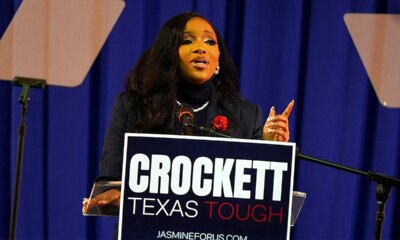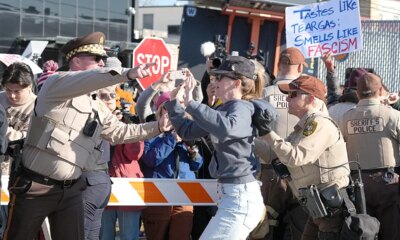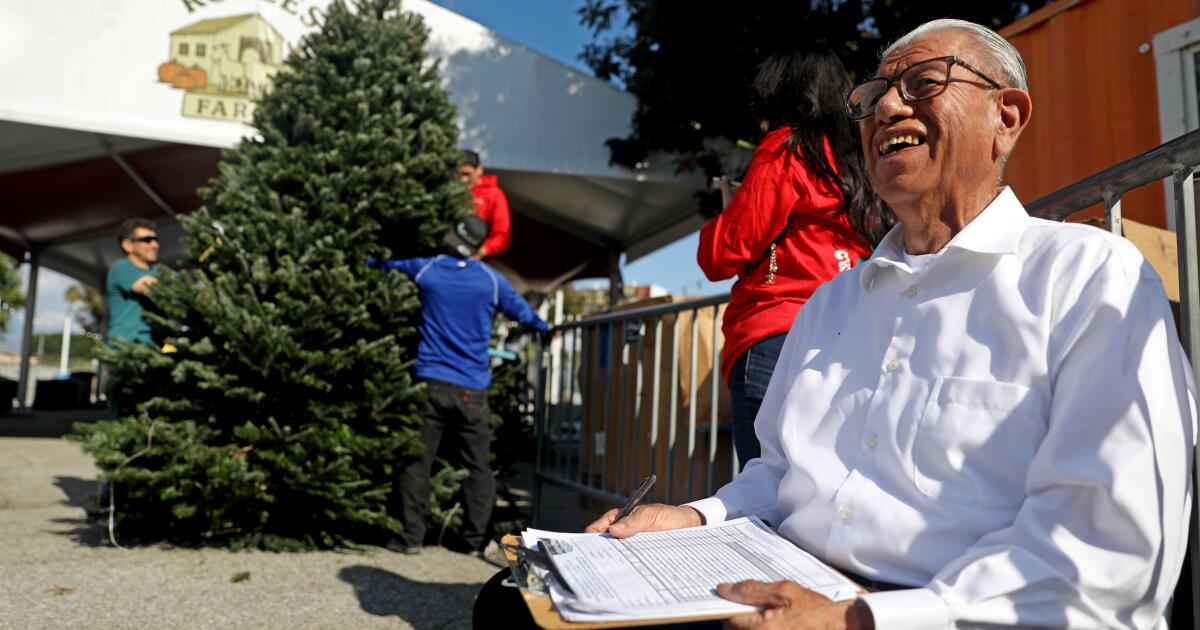Washington
Washington braces for Trump Inauguration

Metal fences, concrete barriers and security checkpoints still line many the walkways and cross streets of the National Mall – extending from the U.S. Capitol down past some of Washington’s most noted landmarks – as the nation prepares to swear in its 47th president.
But while the 0.6-square-kilometer (146-acre) swath of land is often the highlight of many a tourist visit, it is no longer the focus of security efforts for when President-elect Donald Trump takes the oath of office for a second time.
Frigid temperatures forecast for much of Monday led Trump to move the festivities inside – the inauguration to the U.S. Capitol Rotunda and the traditional inaugural parade to the nearby Capital One Arena.
The changes, first announced Friday, presented a last-minute hitch for security and law enforcement officials, who had been planning for the inauguration for the past year.
And it has left them, and the approximately 25,000 law enforcement and military personnel charged with security, with multiple challenges.
“We will shift those assets,” said the U.S. Secret Service’s Matt McCool, briefing reporters Sunday.
“We have not cut anything from what our original plan was,” he said. “I’m very confident, with our partners here, we will be ready.”
The numbers could make the situation especially trying.
Organizers had expected about 250,000 ticketed guests to descend on the U.S. Capitol and the National Mall to watch the inauguration.
Only a select few will be allowed into the Capitol Rotunda, which accommodates just 600 people. And the Capital One Area seats just 20,000.
If even just a fraction of the 250,000 people who had planned on attending the inauguration try to get to the arena, there could be a crunch.
Washington Metropolitan Police Chief Pamela Smith said Sunday her force, bolstered by and about 4,000 police officers from across the U.S., will be ready.
“Nothing has really changed,” Smith told reporters. “The police officers that were committed and dedicated to coming here, we’ll be flexible in how we’ll adjust [their] movement. … So, we will still have police officers in places and spaces around our city as we initially planned.”
Some of those officers, Smith said, will still be assigned to the original parade route in anticipation that some people will try to get a glimpse of the presidential motorcade as it goes by.
U.S. Capitol Police said they also anticipate having officers on the periphery of the West Front of the Capitol – now closed off with the inauguration moved indoors – ready to direct ticketed guests who will no longer be able to attend.
In addition, the inaugural security contingent, which includes the U.S. Secret Service, the FBI, U.S. Capitol Police, Washington Metropolitan Police, and some 7,800 members of the U.S. Army and Air National Guard, will all be coordinated from a command center linked into an expanded network of cameras keeping watch on the city.
And though security measures in some areas, including along parts of the National Mall, have been relaxed, officials said there will be plenty of reminders for anyone coming to Washington that this is no ordinary time.
“They will see tactical teams,” McCool said, during an earlier briefing with reporters last week. “They’ll see, officers and agents on rooftops, they’ll see checkpoints. They’ll see road closures and barriers in concrete.”
Even before the inauguration was moved inside, officials had been preparing for what they described as “a higher threat environment,” cautioning the security plans for this inauguration were already more robust than in the past.
“The biggest threat, I think, for all of us remains the lone actor,” said Capitol Police Chief Tom Manger. “That threat … remains the biggest justification for us being on this heightened stage state of alert.”
Those concerns were heightened following the New Year’s Day terror attack and truck ramming in New Orleans and the Las Vegas Cybertruck explosion outside the Trump International Hotel in Las Vegas, Nevada.
Earlier this month Capitol Police arrested two men suspected of trying to disrupt the state funeral for former U.S. President Jimmy Carter, one who tried to bring knives and a machete into the Capitol and another who set their car on fire.
Research, including a recent survey by the University of Chicago Project on Security and Threats, adds to the concerns.
“Over 5% of the American public supports the use of force to prevent Donald Trump from becoming president,” Robert Pape, the project’s director, told VOA.
“That equates to 14,000,000 American adults,” he said. “That’s an unfortunately disturbing number.”
Already, Trump was also the target of two attempted assassinations.
There is also an ongoing threat from Iran. Despite repeated Iranian denials, U.S. security and law enforcement officials have accused Tehran of trying to kill Trump, unveiling one plot set to be carried out last year, in the days after the U.S. presidential election.
For now, though, U.S. officials see no signs of impending trouble.
“The FBI is not currently tracking any credible or specific threats to the inaugural ceremony or the Capitol complex,” the bureau’s Washington Field Office told VOA. “We will continue to work closely with our partners to share information and identify and disrupt any threats that may emerge.”
Another source for concern is the tens of thousands of protesters, though so far, there have been no major incidents.
Saturday’s People’s March, which was permitted to have as many as 50,000 protesters, sparked only brief tensions with Trump supporters.
Another group, called We Fight Back, has permits for protests involving about 10,000 people in across several locations on Monday.
“Please note that [we] will ensure your right to peacefully protest and assemble,” said the Metropolitan Police Department’s Smith.
“However, I want to reiterate, as I always have, that violence, destruction and unlawful behavior will not be tolerated,” she said. “Offenders will face swift and decisive consequences … anyone who thinks that they can come into this city to destroy property, we will be prepared to deal with them.”
Kim Lewis contributed to this report.

Washington
Washington Capitals 2025-26 W Magazine Now Available | Washington Capitals

Arlington, Va. – W Magazine, a lifestyle publication produced by the Washington Capitals, is now available for purchase online at www.washcaps.com/wmagazine and at the Team Store at Capital One Arena and at the Team Store at MedStar Capitals Iceplex. The fan-favorite magazine, which features content surrounding every Capitals player along with hundreds of personal, never-before-seen family photos, is available for $8 plus shipping. In addition, season ticket members will receive a complimentary issue, with copies for season ticket members available at the Planholder Hub on the 100-level concourse during Capitals home games.
The cover story, written by Capitals senior writer Mike Vogel, goes in-depth with forward Pierre-Luc Dubois. Vogel speaks with Dubois, his teammates and family members for an extensive feature on the phone call that changed Dubois’ life and shaped his future with the Capitals franchise. Spanning more than 200 pages, W offers exclusive photography of Capitals players and their families, along with lifestyle content and interviews with every member of the 2025-26 roster. Highlights include:
- John Carlson on fishing in Maryland with his sons
- Brandon Duhaime on spearfishing and his related YouTube channel
- Ryan Leonard on moving to D.C. and living with the Dubois family
- Charlie Lindgren on his first offseason as a dad
- Alex Ovechkin on celebrating back home after becoming the NHL’s all-time leading goal scorer
- Logan Thompson on his love of dogs
- Trevor van Riemsdyk on pop-a-shot and pickleball
The magazine also features an in-depth look at the Capital One Arena transformation project, including exclusive photos, insights into future phases and Capitals player reactions to the new Capitals locker room complex. A special interview with Monumental Sports Network’s Joe Beninati and Craig Laughlin reflects on the historic 50th anniversary season, while a day-in-the-life piece with Caps Radio’s John Walton and Katie Florio brings readers behind-the-scenes of a home game radio broadcast.
Additional features include a look at a regular day for former Capitals service dog in training Biscuit – now a facility dog at Walter Reed National Military Medical Center – and a photographic recap of Alex Ovechkin’s historic 2024-25 season. A new “Beyond the Boards” section spotlights community stories, while the fan-favorite “Short Shifts” section returns with Capitals players sharing thoughts on topics such as the best singer on the team, funniest teammate, personal goals beyond hockey, what everyone should try at least once, their ideal entrance theme song and more.
The magazine also profiles members of the Capitals Black Hockey Committee and introduces fans to the team driving the organization’s youth hockey initiatives.
W design services were provided by Matt Ryan. Player photography was provided by Greg Powers with assistance from Damon Banks. The cover featuring Pierre-Luc Dubois was photographed on the Potomac River in Washington, D.C., with the assistance of captains and crew from City Cruises. Players were photographed for the publication at Origin in Arlington, Va.
Washington
Ginger’s Journey: Walking from Washington State to Washington, D.C.

Imagine setting out, on foot, for a journey not knowing how long it would take. Now imagine doing it with two animals as traveling partners from Washington State to Washington, D.C.
“Now I’ve started this leg of the journey in Morton, Washington where I was spiritually requested to go to Washington, D.C. and sing the song ‘Imagine’ by John Lennon on the Capitol steps,” says Jacob Holiday.
Jacob Holiday is on his way across America so he can sing a song he says signifies peace in the hopes, he says, of ending violence everywhere.
“I want so much peace. Cops would no longer carry firearms. We’re going to send the militaries of every country, I don’t care which one you’re talking about but every country, home to go to sleep. I don’t care what they do. But I want all this violence, everything, all this violence to stop.”
He has two wagons and his traveling companions are a dog and a goat. Holiday started in Washington State in July and he’s not worried about how long his hike across America will take.
His multi-state trek has seen him encounter a lot along the way, including a run-in with a bear.
He carries food for himself and his dog and his goat on carts that he says weigh a couple hundred pounds. Besides necessities, Holiday has one thing he’d greatly appreciate receive being able to buy as he continues his mission.
Holiday says he knows his mission isn’t an easy one, and he uses it as a metaphor for life as a whole.
We caught up with Holiday in the early part of November on a 70-degree day in Cambridge, Nebraska then spoke to him again a few days later in the rain as he headed east on Highways 6 and 34, so no telling how far he’s gotten now.
After we met with Holiday, we did notify the local sheriff to perform a welfare check, but we’re told Holiday wanted to continue his walk with his Capitol Steps goal still ahead of him. We also offered him food for himself and his animals, which he declined saying he had enough food on his carts.
Washington
Washington state flooding damage profound but unclear, governor warns

The extent of the damage in Washington state is profound but unclear after more than a week of heavy rains and record flooding, according to the state’s governor, Bob Ferguson.
A barrage of storms from weather systems stretching across the Pacific has dumped close to 2ft (0.6 metres) of rain in parts of the state, swelling rivers far beyond their banks and prompting more than 600 rescues across 10 counties.
More high water, mudslides and power outages were in the forecast. Elevated rivers and flood risk could persist until at least late this month, according to the National Weather Service. Wind and flood watches and warnings are expected in much of the north-west for the next couple of days as storms bring rain, heavy mountain snow and high winds.
As of Tuesday, authorities had recorded one death – of a man who drove past warning signs into a flooded area – but key highways were buried or washed out, entire communities had been inundated, and saturated levees had given way. It could be months before State Route 2, which connects cities in western Washington with the Stevens Pass ski area and the faux Bavarian tourist town of Leavenworth across the mountains, can be reopened, Ferguson said.
“We’re in for the long haul,” Ferguson said at a news conference. “If you get an evacuation order, for God’s sakes, follow it.”
It won’t be until after waters recede and landslide risk subsides that crews will be able to fully assess the damage, he said. The state and some counties are making several million dollars available to help people pay for hotels, groceries and other necessities, pending more extensive federal assistance that Ferguson and Washington’s congressional delegation expect to see approved.
According to the governor’s office, first responders had conducted at least 629 rescues and 572 assisted evacuations. As many as 100,000 people had been under evacuation orders at times, many of them in the flood plain of the Skagit River north of Seattle.
-

 Iowa4 days ago
Iowa4 days agoAddy Brown motivated to step up in Audi Crooks’ absence vs. UNI
-

 Washington1 week ago
Washington1 week agoLIVE UPDATES: Mudslide, road closures across Western Washington
-

 Iowa5 days ago
Iowa5 days agoHow much snow did Iowa get? See Iowa’s latest snowfall totals
-

 Maine2 days ago
Maine2 days agoElementary-aged student killed in school bus crash in southern Maine
-

 Maryland4 days ago
Maryland4 days agoFrigid temperatures to start the week in Maryland
-

 Technology1 week ago
Technology1 week agoThe Game Awards are losing their luster
-

 South Dakota4 days ago
South Dakota4 days agoNature: Snow in South Dakota
-

 Nebraska1 week ago
Nebraska1 week agoNebraska lands commitment from DL Jayden Travers adding to early Top 5 recruiting class























